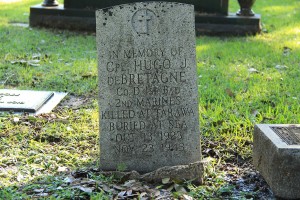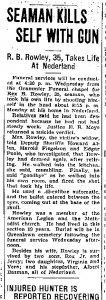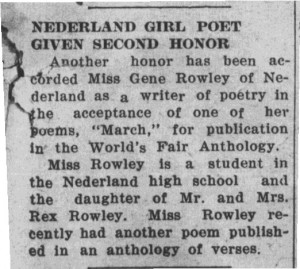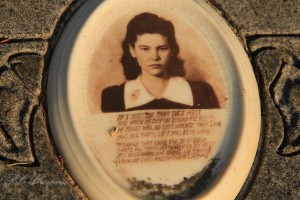While walking through Greenlawn Cemetery in Groves one mid-August morning, I came across a monument erected by the American Legion Auxiliary. Surrounding the stone memorial, which was inscribed “They gave their lives that freedom shall not perish,” were the graves of several veterans. Although most survived the conflicts of World War I, World War II, Korea, and Vietnam, and subsequently went on to lead healthy lives with their loved ones, there was one memorial that differed from the rest. Corporal Hugo J. DeBretagne, it seemed, paid the ultimate price for his country and never returned. The inscription on his headstone reads:
In memory of Hugo J. DeBretagne, CO D 1st Bat. 2nd Marines Killed at Tarawa Buried at sea. Oct. 13, 1923 – Nov. 23, 1943
There are multitudes of stories at the cemetery that I would like to pursue. Many veterans lived simply and some even heroically, but there are no claims to their historic pasts. In fact, most of us will similarly end up forgotten in the end. It’s sad but true; most of our history will disappear when we die. There may be a few friends and/or family members who will grab the torch and try to prop us up for eternity, but ultimately, death, for most, is where personal history ends.
As I maneuvered through the area to take photographs of the residents’ headstones, I came across what will probably go down as one of the oddest mysteries in my search through SETX history. Located near the American Legion’s monument was a flat headstone with an image of the deceased in porcelain. This is not entirely unusual in and of itself, but the text that went along with the image was very disturbing to say the least:
If I must die then die I must and when the coffin round me rusts my bones will go whence they came and all that’s left is my name. To shield that name I’ll do my best; that’s all that’s left when I’m at rest. I’ll do no harm and bring no shame upon my dad and mother’s name.
Not really a poignant tribute to an attractive 20 year old who lost her life so young, is it? So who was she, and what was her story? Let’s try and piece together this tale.
Virginia Lee “Gene” Rowley
While doing research that evening, I came across a couple of leads, but unfortunately (as usual), the facts didn’t add up to the reality. My first find was an IMDB page for a 12-minute film called Roothold (2004). It was directed by, and starred, Port Arthur native Eric Patrick alongside Jennifer Baker. According to the IMDB plot summary, the film has some historical significance:
Roothold is a divination film that speculates on Gene Rowley: a woman pictured on an abandoned gravestone in Port Arthur, TX. The film is an elusive narrative that places the filmmaker in an emotional and psychic state of ceremonially rehearsing for mortality and burial.
– Written by Anonymous
I looked for Eric Patrick’s website but all I could find was his Wikipedia page:
https://en.wikipedia.org/wiki/Eric_Patrick
The second—and last—mention of this mystery that I found on the internet was on an Angelfire web site. You remember those free sparkly web sites that never really amounted to much? I could hardly believe this one was still up and running, but there it was, in all its glory. It shared the following story:
The story of Virginia Rowley, ‘Gene’ as her family and friends called her, is a sad one. Gene was born on October 8, 1922 in Port Arthur, Texas. Gene’s father, Clyde, worked for the city as a railroad operator. Gene’s mother, Martha, was a seamstress with a strange disposition. The strange behavior would today probably be diagnosed as bipolar disorder, something that Gene likely would have been diagnosed with as well. Gene was the eldest of four children; Elroy, Clyde Jr. and Tara. Martha would require the children in church each Sunday; usually promptly switching the children with branches for doing the slightest thing. Though Martha loved her children; she was aggressive and was quick to anger. The children grew up attending private schools. The children, especially Gene and Tara were not allowed to date. This was taboo for Martha until her children came of age. Though Martha kept the children under her wing to an extreme degree; she demanded that they make their own way in life by obtaining jobs at a young age. Martha encouraged the children to live at home so that she could keep a close eye on them. By 18, Gene ventured from the nest, shortly after graduating and took a job as a telephone operator for Southwestern Bell. She became independent and even found a boyfriend. The dashing young man was 22-years-old, his name was James. It was instant love for Gene. The two became inseperable; this was something Gene went to great depths to hide from her mother. Though Gene was on her own; Martha did not approve of James. Martha thought of James as too worldy. Gene was more of a straight laced girl to Martha; she needed a likewise young man. Martha, too, didn’t approve of James’ age. After a year long union Gene discovered the unthinkable. She was expecting a child. James was confronted with the issue; to Gene’s disbelief; James fled Port Arthur, refusing to contact Gene. Heartbroken and betrayed; Gene confronted several friends and relatives with the issue; they all assured her that they would help her and everything would work out, however, Gene knew that this would shame and devastate Martha a great deal. On June 18, 1942, Gene took the day off from work and stopped by Martha and Clyde’s to say hello. Gene never breathed a word about her pregnancy to her parents. It was simply a good bye visit. Gene later drove to Nederland. Once there, Gene found an unoccupied truck and plowed into it. Gene died shortly after reaching the hospital. That night Martha found a note (At top) that Gene had left in her bedroom while visiting that day. It became quite clear that this had been no accident. The reasons were quite clear. Gene’s pregnancy would have brought harm and shame to her parents name.
Knowing this, the first site was possibly an author/director’s take on the mystery. It was honest enough I guess, but I haven’t seen the movie, nor do I know how to watch or buy it. To be frank, the second site comprised plain nonsense. The author had devised an epic story around a few facts but failed significantly in producing details, resulting in what I can only assume was an attempt at historical fiction. All names, except Virginia’s, were inaccurate, so if the narration of a historical tale was intended, it was shoddily done. I wondered if both the first and second sources were related. I still have no idea, but their timeframes were similar. Again, I haven’t seen the 12-minute movie and IMDB was scant on detail.
But now that we have discussed what is online, let us delve into some of the “real” facts.
Virginia “Gene” Lee Rowley was born on October 16, 1922 in Nederland, Texas to Rex Blanton Rowley and O’ciela M. Roy. She was the oldest of four siblings. Her brother Rex, who was born in 1924, would go on to serve in World War II. Vera, her sister, was born in 1925, and the youngest of the bunch, her brother Jerry, was born in 1928. I found very little on their childhood other than that they lived in the Van Oostrom addition. (This addition, according to records, is the area around Van Street and Herring Avenue in Port Neches.) The father Rex, a World War I veteran, served with Company C, 9th Infantry, and held several jobs through the years. The records showed that he was a machinist at an oil refinery (the name of which one is unknown) in the 20s, and at other times a dairyman (in Nederland) and a seaman.
In November of 1934 I can only assume that life changed dramatically for the Rowley family because the father Rex decided to take his own life in their house. Obviously I’d be promoting the same theorizations as those who speculated on Virginia’s scenario, so I will disregard my thoughts as to why he may have taken this extreme route and terminated his life, leaving a wife and four children behind to fend for themselves. I will say that Rex’s exposure to the vile war (1916–1919) is currently unknown, but I can only surmise that his experience would have been unimaginable if he had seen the front.
Knowing that Virginia’s father died so tragically, I wondered if this was the origin of the inscribed words that were placed on her headstone eight years later. Unfortunately we will possibly never know, but there is more to this story than a couple of web sites will tell.
Virginia eventually moved to San Antonio where she was employed as a radio operator in Duncan Field. Virginia met her demise on Frio City Road in an auto accident in the early morning hours of July 24, 1942. The death certificate stated that her death was an accident, not suicide. There was no mention of a pregnancy in any of the documents that I found.
The tragedy of the family would continue almost 20 years later. Rex, the oldest remaining sibling, was electrocuted while working on an air-conditioning unit in 1961. He is also buried in Greenlawn Cemetery, next to his mother O’ciela who died in 1963. Jerry H. Rowley died of a cardiac arrest in 1981 leaving Vera as the sole sibling. Vera, as far as I can tell from the records, died in 2008. I say this because a Vera B. Rowley married an Elmo J. Rowley in Port Arthur in 1943, but that doesn’t fit the other available records. Also, Vera and Jerry are not listed in the relevant census and city directories of the 20s, 30s, and 40s, although I do know that they were siblings to Virginia because of their birth and death certificates.
There is a further mystery. According to the 1920 census, O’ciela (or Ciela in some documents) was the daughter of Albert and Metta Wee Bossman and lived with her husband Rex B. Rowley. It is an original document, but I see no way that it can be right since all other documents state that her parents were A.J. and Maria Alida Roy.
There was much tragedy in this family, and I would certainly not want to resuscitate any negative memories for their descendents. I would however somehow like to find out the meaning of the words on the headstone. Was it some sort of tribute or perhaps a memorial left by the living family members? Was it Virginia’s poem? The tragic loss of a father for a 14-year-old girl could certainly have brought out thoughts of sorrow. She may even have felt partially to blame for the tragedy. Did her mother O’ciela write it? This is quite possible, but until I find evidence, I could not say for sure. My only goal in this saga was to bring to light the facts about Virginia, but as I dug deeper, this family’s ongoing tragedies and mysteries came to the fore.
If anyone knows any part of this story or has knowledge of the family, I would love to hear from you.
rediscoveringsetx@gmail.com
Update: 1/04/2016
What a difference a week and a few newspaper archives can make! While conducting research for my next endeavor, I veered off my intended path and found myself back on the Rowley’s trail. I inadvertently unearthed a few more answers to some of the questions that were still puzzling me about the Rowley family.
Rex B. Rowley Sr.’s death
A Port Arthur News article dated November 27, 1934 informed its readers of Rex’s death and the probable cause of his suicide:
“Relatives said he had been despondent because he had not had steady work. Justice E.B. Moye returned a suicide verdict.”
I have included a photo of the full news article here. 
Who was Albert Bosman?
Another mystery the article cleared up was the link between Albert Bosman and the family. As previously explained, I had discovered a 1920 census showing O’ciela as the daughter of Albert Bosman and “Metta Wee.” I was certain this was an error because all the other documents pointed to Andrew and Maria Roy being her parents. The truth was revealed at the end of the article: Albert Bosman was actually Rex’s stepfather.
“Besides his wife, Rowley is survived by two sons, Rex Jr. and Jerry; two daughters, Virginia and Vera; and his stepfather, Albert Bosman, all of Nederland.”
I also discovered that “Metta Wee” was the maiden name of Vera, Rex’s mother.
Who wrote the poem on the headstone?
I still cannot say for sure, but I found a few articles in The Chronicle (1939) that offer a clue.
 A February 17 article entitled “Nederland girl, poet given second honor” announced that one of Gene’s poems, “March,” was to be published in the World’s Fair Anthology. It went on to say that Virginia (Gene) had previously had a poem published in an anthology of verses.
A February 17 article entitled “Nederland girl, poet given second honor” announced that one of Gene’s poems, “March,” was to be published in the World’s Fair Anthology. It went on to say that Virginia (Gene) had previously had a poem published in an anthology of verses.
Another article, dated November 10, 1939, stated that O’ciela Rowley was the author of a poem appearing in Christmas Lyrics of 1939, which had been published by Beacon Publications.
“This anthology, according to the Beacon concern, has been issued annually since 1936. Work of Mrs. Rowley already has appeared in the World’s Fair Anthology.”
This I found very interesting. Were both mother and daughter published poets? It is possible, but as I’ve discovered through my research, you should never assume that the printed word is without errors. I do believe Virginia was an accomplished poet. At Nederland High School, I found multiple articles on her awards as well as her studies. And this makes me think that she was indeed the source of those dark words etched under the photo on her headstone. Again, we will probably never know for sure, but it seems we are getting closer…


You must be logged in to post a comment.